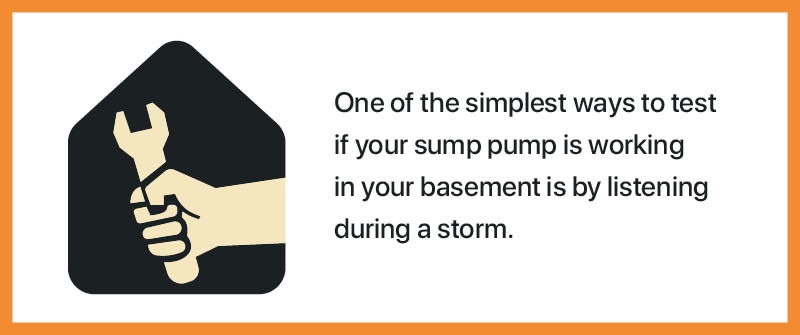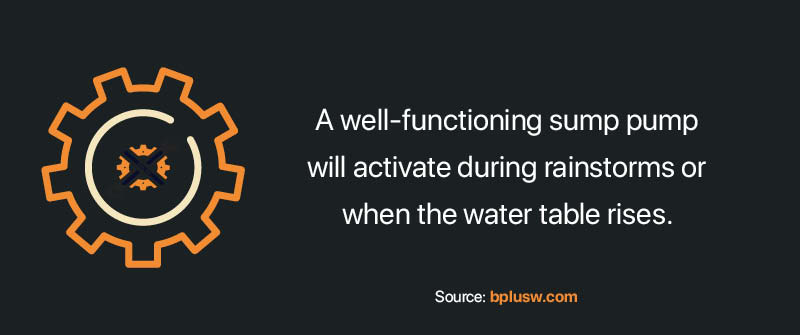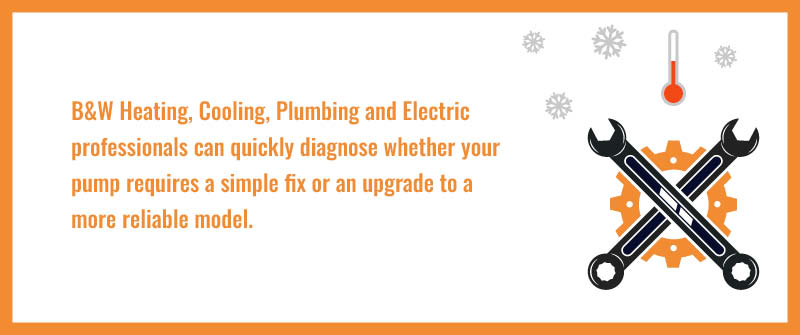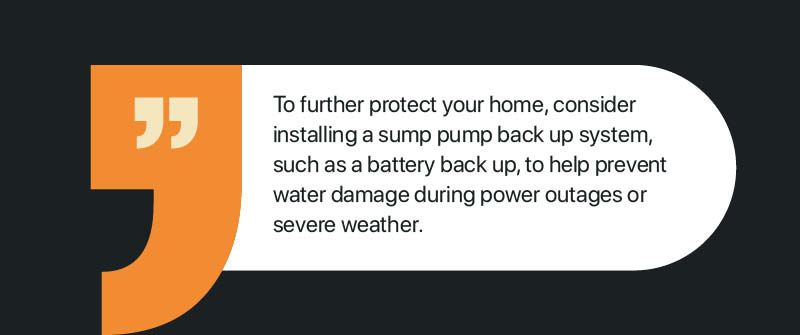How To Tell If A Sump Pump Is Working
How Do I Check If My Sump Pump Is Working?
Ensuring your sump pump is working properly is one of the most important steps you can take to protect your basement from flooding and water damage. To check if your sump pump is operational, you can perform a few straightforward tests and visual inspections, even without waiting for a rainy day. By understanding the signs of a healthy sump pump and knowing what to look for, and by relying on professional plumbing services when needed, you’ll gain peace of mind and make your home less vulnerable to water issues.
How to Tell If Your Sump Pump Is Working: Key Signs
The most obvious indicator that your sump pump is working in your basement is its response to water. You can determine if your sump pump is functioning properly by performing simple checks. During a rainstorm, listen for the hum or soft rumble of the pump turning on and off as water enters the pit. You can figure out if your sump pump is operational by watching for these key signs. If you see water receding from the sump pit during or after rainfall, that’s a great sign your pump is handling its job. Be sure to watch for these indicators during and after rainfall to assess performance. If your sump pump is not working, you might notice stagnant water, unpleasant odors, or dampness creeping over the basement floor—these are signs you should investigate further. Homeowners shouldn’t worry, as these checks are straightforward.
Steps To Visually Inspect Your Sump Pump In The Basement
Before starting your inspection, locate the sump pump and pit in your basement. Start by looking at the physical condition of your sump pump and pit. Make sure the power cord is plugged in and undamaged, and check for any rust, debris, or obstructions around the unit. The sump pump and pit are typically located in the lowest part of the basement, often near a wall or corner where water collects. The pit should be clear of large amounts of dirt or objects that might block the float switch or pump intake, as these blockages can cause predicaments like your sump pump not working.
Listen For Operational Sounds During A Rain Event
One of the simplest ways to test if your sump pump is working in your basement is by listening during a storm. The pump should cycle on as the water level begins to rise and trigger the pump, then cycle off once the water is removed. Strange noises like clanking, grinding, or clicking signal that the pump or switch may need attention. If your pump is silent when you expect it to run, further testing is warranted.
Testing A Sump Pump Switch Manually
You can test the sump pump switch by gently lifting the float (the arm attached to the pump that rises with water). The float should move freely; as you lift it, the float should trigger the pump to turn on within a few seconds. If nothing happens, ensure the pump is getting power and no circuit breakers have tripped. If the float mechanism feels stuck or the pump doesn’t respond, you may need professional help to diagnose the issue.
How To Test A Sump Pump Without Water Using The Float
If you want to test your sump pump without water, use the following method: slowly lift the float arm as described above. Many modern pumps will activate simply by raising the float, even in the absence of water. This is a safe way to check functionality without introducing water into the pit. If the pump whirs to life, you’re in good shape. If it doesn’t, look for electrical or switch problems before considering a replacement.
Routine Maintenance Checks And What To Look For
Schedule periodic visual inspections of your sump pump, especially before the rainy season. Look for worn cords, visible rust, sediment buildup, or debris in the pit. Don’t forget to check the discharge pipe outside to make sure it’s clear and water flows freely away from your foundation. Regular checks help you avoid messy surprises—and if you’d rather have professional peace of mind, B&W Heating, Cooling, Plumbing and Electric is always a call away to ensure your pump is ready to perform when you need it most!
How To Tell If A Pump Is Working
Wondering if your sump pump is working properly is common for many homeowners, especially with unpredictable weather and the risk of basement flooding. The easiest way to tell if your sump pump works is by observing its behavior during heavy rain, listening for operational sounds, and running simple tests, such as manually lifting the float or testing the switch to confirm the sump pump works as intended. If you’re ever unsure or your sump pump isn’t responding, it’s always a smart call to have a professional inspection. Below, we’ll break down exactly how your pump functions, what signs to look for, and how to safely test it to give you peace of mind and protect your home.
How Does A Sump Pump Work: Basics Every Homeowner Should Know
Your home’s sump pump plays a critical role in preventing water damage by automatically moving water away from your basement or crawl space. The pump typically sits in a sump pit below your basement floor. When water fills the pit to a certain level, the pump is triggered—usually by a float switch or digital sensor—and begins moving water through a discharge pipe, safely away from your foundation. Understanding this process is important because proper pump function depends on each of these moving parts working correctly.
Indicators Of Proper Sump Pump Performance
A well-functioning sump pump will activate during rainstorms or when the water table rises. Key indicators include hearing the motor running smoothly when water enters the pit, the float rising and triggering the pump, and water efficiently flowing out of the discharge line. Some sump pumps also feature an indicator light that shows when the pump is powered or operating, providing a clear visual sign of proper function. You should not see standing water in the sump pit after the pump has operated. Also, the area around the pump should remain dry—dampness or puddles could signal an issue.
Common Issues That Can Prevent The Pump From Working
Sometimes, your sump pump may be installed correctly but fail due to issues like a stuck or faulty switch, a clogged intake, or a loss of power. Worn or corroded electrical contacts can also prevent the pump from working properly, as contacts are essential for maintaining electrical continuity and ensuring safe operation. An unresponsive float, excessive vibration, or silence from the pump during a storm are signals that something may be wrong. If the pump cycles on and off rapidly, makes odd sounds, or fails to discharge water, it might need maintenance or professional repair. Checking periodically for these issues reduces your risk of unexpected basement flooding.
Testing Sump Pump Operation Safely
To test your sump pump safely, slowly lift the float switch. If the pump starts, it’s a good sign your switch and motor are functional. You can also pour a bucket of water into the sump pit to see if the pump turns on and drains the water effectively. Always remember, if you suspect electrical trouble or aren’t comfortable testing it yourself, B&W Heating, Cooling, Plumbing and Electric’s experienced team is just a call away, ready to ensure your basement stays dry and protected all year round.
With regular checks and awareness of how your sump pump should sound and operate, you can rest easy knowing your home is prepared for whatever the weather brings.
How Do I Know If My Sump Pump Is Burned Out?
If your sump pump is not working and you’re suspecting something more serious than a minor glitch, it’s wise to consider whether it’s suffered an electrical burnout. Power surges or a short period of excessive current can sometimes cause electrical burnout in the pump’s motor. Common signs of a burned-out sump pump include total silence when it should be running, a persistent failure to turn on, or even a tripped circuit breaker. Before making any decisions, knowing how to distinguish between a mechanical failure and an electrical burnout can help you act promptly and protect your basement from potential flooding.
What’s The Difference Between Mechanical Failure And Electrical Burnout?
Mechanical failures in sump pumps usually involve worn-out parts, stuck floats, or clogged impellers that prevent the sump pump from working efficiently. Electrical burnout, on the other hand, is typically the result of prolonged overheating or an internal wiring short, causing the pump’s motor to stop working entirely. If your sump pump runs continuously but never pumps water, you’re more likely facing a mechanical issue. If it won’t start at all, especially after storms or power surges, electrical burnout might be to blame.
Signs Your Sump Pump Motor Is Burned Out
You can spot a burned-out sump pump by checking for these typical clues:
- No Noise or Operation: The unit doesn’t make any sound, vibrate, or attempt to start when the float switch lifts or you manually test it.
- Repeated Tripping of the Breaker: If turning on the pump immediately trips your breaker or blows a fuse, this points toward an internal motor short.
- Visible or Smellable Damage: Sometimes you may notice an acrid electrical smell or see scorch marks on the pump casing—both strong indicators that the motor has burned out.
Utilizing The Sump Pump Reset Button
Many pumps include a reset button. To attempt a reset, unplug your pump and allow it to cool down for 10-15 minutes if it’s hot. After plugging it back in, press the reset button as instructed in your owner’s manual. If the pump remains lifeless or immediately re-trips the breaker, the motor has likely burned out and needs further attention.
What To Do If Your Sump Pump Doesn’t Reset
If resetting doesn’t work and your sump pump is not working, avoid further attempts to forcibly start the unit, as this could create a safety hazard. Double-check that power is being delivered to the outlet using another device, and inspect the sump for debris that could have caused overheating. If everything checks out and your pump still won’t run, it’s time to consider a replacement or professional repair.
When Should I Call A Professional?
Sometimes, it’s not worth risking your peace of mind or your home’s dryness by troubleshooting alone. If you’ve tried a reset, checked your breakers, and your sump pump is not working, contact the experts at B&W Heating, Cooling, Plumbing and Electric for professional assistance. Our licensed professionals can quickly diagnose whether your pump requires a simple fix or an upgrade to a more reliable model. We recommend American Standard and Ameristar. At B&W, our goal is to keep your basement dry and your home operating safely year-round. When in doubt, contact us to let us take a look and provide the best solution for your family’s comfort and security.
How To Tell If My Sump Pump Is Clogged Or Blocked
Dealing with a sump pump not working can be stressful, especially when you suspect a clog might be the culprit. Fortunately, identifying and resolving a blockage isn’t as daunting as it sounds when you know what to look for and how to proceed. Catching a clog early can spare you from water damage and possible basement flooding, keeping your home safe and dry all year long.
Water intrusion from a clogged sump pump can lead to moisture damage in basement walls, which may result in mold growth and even structural issues if left unaddressed.
Let’s explore the symptoms of a clogged sump pump, how to inspect your system, and tips to prevent clogs in the future.
Symptoms Of A Clogged Sump Pump
One of the first signs of a clogged sump pump is water lingering in your sump pit even though your pump is running, or worse, not running at all. You might also hear the motor humming without any water being discharged, or notice strange gurgling sounds. If you smell a musty odor near your sump pump, it’s possible that stagnant water is causing mold growth due to insufficient drainage. These issues almost always indicate a blockage somewhere in the system that needs attention.
How To Inspect Discharge Lines And Intakes
The heart of the problem often lies in the intake area or the discharge line. Start by unplugging your sump pump for safety, then check around the intake screen and the base of the pump for debris like dirt, gravel, or pet hair that could be blocking water flow. Next, move outside and trace your discharge line, ensuring there’s no blockage from soil, leaves, ice, or even small rodents that sometimes find their way inside. A blocked discharge line will restrict the flow and might be the reason your sump pump is not working effectively.
Signs Your Sump Pump Is Running But Not Pumping
If you hear your sump pump motor activating but see no movement of water, or if the water level in your pit never seems to drop, this typically signals a clog. Consistently running without removing water is not only inefficient but can also burn out your pump’s motor, leading to more costly repairs down the road. Regularly check the water level during heavy rain or periodic pump cycles to ensure the system is operating as expected.
Steps To Safely Clean And Clear Potential Blockages
Before cleaning, always unplug the pump to avoid electrical hazards. Gently remove any visible debris from the intake screen and sump pit. If the discharge hose is clogged, detach it and flush it thoroughly with a garden hose. Some simple soapy water and a long brush can help remove built-up grime inside the pipes. Once everything is clear, carefully reattach the pump and plug it back in. Run a quick test by filling the sump pit with a few gallons of water to confirm that water is moving freely from the pit to the discharge point.
Preventative Maintenance Tips To Avoid Future Clogs
Routine maintenance makes a world of difference in the health of your sump pump. Schedule a seasonal cleaning; spring and fall are perfect times. Make sure your sump pit remains free of loose debris and occasionally check the discharge line, especially after storms or in the winter when ice is a risk. If you’d rather leave it to the experts, B&W Heating, Cooling, Plumbing and Electric offers thorough sump pump inspections, cleaning, and repair services, so you can feel confident your basement is protected against unexpected water issues.
Can You Shower If Your Sump Pump Is Not Working?
In most cases, it’s best to avoid using showers or any high-water-producing plumbing fixtures if your sump pump is not working. While a sump pump’s main role is to remove groundwater from your basement, a malfunction can indirectly impact your home’s overall drainage system, especially if your home’s plumbing discharges significant water into the sump pit or if heavy rains rapidly raise groundwater levels. Using the shower can risk overwhelming the sump basin and nearby drains, increasing your chances of a water backup or even basement flooding.
How A Malfunctioning Sump Pump Can Impact Household Drains
If your sump pump is not working in the basement, any water entering the sump pit—whether from rain, appliances, or plumbing fixtures—won’t be pumped out efficiently. This means water might accumulate, overflow into your basement, or contribute to an overall backup in your drainage system. In homes where basement bathroom drains, laundry, or utility sinks are connected in a way that leads to the sump pit, using these fixtures (including showering) while the pump is down can quickly exacerbate the problem.
Risks Of Using Plumbing Fixtures During A Sump Pump Failure
When your sump pump isn’t operational, every extra gallon of water draining to the pit increases flood risks. Not only could this cause property damage, but it also creates slip hazards and the potential for mold growth if standing water accumulates. If you have a finished basement or store valuables below ground level, a failed sump pump plus ongoing fixture use can mean expensive restoration work.
Assessing Water Backup Dangers In Basements And Lower Levels
If your basement or lower level already shows signs of dampness, slow drains, or rising water during or after showers, it’s a red flag that backups may quickly follow. Evaluate your basement regularly for any water pooling, especially near the sump pit or floor drains. If you notice unusual water behavior while using plumbing fixtures, discontinue their use until the sump pump is serviced.
Recommendations For Homeowners During Pump Outages
If your sump pump is not working, limit the use of plumbing fixtures as much as possible until repairs are made. Avoid long showers, running the washing machine, or draining large volumes of water into your plumbing system. If avoiding showering isn’t an option, be prepared to monitor the basement for water accumulation or have towels and a wet-dry vacuum on standby.
To further protect your home, consider installing a sump pump back up system, such as a battery back up, to help prevent water damage during power outages or severe weather.
Above all, don’t try to push your luck! The safest course is to schedule a prompt repair with professionals like B&W Heating, Cooling, Plumbing and Electric. Our highly trained plumbers can quickly diagnose and restore your sump pump, reducing risk to your basement and providing tips on preventative maintenance. That peace of mind is invaluable, especially during Indiana’s heavy rains or spring thaws.
When To Call A Professional: Sump Pump Repairs And Upgrades
If your sump pump is not working after basic troubleshooting, it’s a clear signal that it’s time to bring in a professional. While some minor sump pump issues, like resetting a tripped breaker or checking a clogged discharge line, can be handled by handy homeowners, more complex problems are best diagnosed and fixed by an experienced plumber. Professional intervention ensures your home stays dry and protected from potential water damage, especially during heavy rain or sudden thaws.
When Basic Troubleshooting Isn’t Enough
Simple checks like lifting the sump pump’s float switch, clearing debris, or inspecting the power connections solve many problems. However, if your pump fails to turn on, makes unusual noises, cycles continuously, or refuses to pump water from the pit, you’re likely facing an issue beyond a DIY fix. Persistent issues often indicate worn-out parts, electrical failures, or hidden blockages in the system. At this stage, calling a technician is vital not only for your peace of mind but for preventing expensive water damage in your basement or crawlspace.
How Professional Plumbers Diagnose Sump Pump Issues
Licensed plumbers go beyond surface-level inspections. They’ll assess your system’s age, check for proper pump sizing, examine the power source and backup systems, and ensure that all switches and floats are operating as they should. With the knowledge to accurately identify issues with the float and other components, professionals can quickly pinpoint the root of the problem. Using specialized tools and their expertise in how sump pumps work, these professionals look for leaks, faulty check valves, and discharge line issues. Such comprehensive diagnostics guarantee a thorough fix instead of a temporary solution, giving you confidence that your sump pump will be ready when you need it most.
The Importance Of Expert Repairs And Regular Maintenance
Professional sump pump repairs restore reliable operation and prolong equipment life. Regularly scheduled maintenance by a qualified plumber helps prevent sludge buildup, rust, and mechanical wear before they result in failure. A good service provider will test the pump under load, clean vital components, evaluate your drainage system, and alert you if any replacement is advisable. This proactive approach saves you from surprise leaks and costly basement repairs down the road.
Considerations For Sump Pump Replacement Or Upgrading
If your sump pump is not working due to old age or recurring malfunctions, you may need to replace it. Most sump pumps have a typical lifespan of about 7-10 years and may need to be replaced after several years of use. Upgrading to a new sump pump can provide improved efficiency, quieter operation, and often includes backup battery systems to keep operating during power outages. When selecting a replacement, consider factors like your basement size, water table level, and existing drainage setup. A professional plumber can install a new unit to ensure proper operation. If your old pump has been replaced, be sure to follow the manufacturer’s instructions for setup and maintenance. A professional plumber can help assess your needs and recommend the right unit, ensuring your home stays safe, dry, and mold-free for years to come.
Choosing The Right Sump Pump For Your Basement
The market is full of sump pump models, each offering different features and advantages, from submersible designs to pedestal pumps and units with smart monitoring. A reputable plumber will guide you through these choices, weighing flow rate, durability, and compatibility with your current system. Proper installation by experts guarantees reliable performance while protecting your investment and your home’s foundation.
Don’t let sump pump trouble put your home at risk. With B&W Heating, Cooling, Plumbing and Electric, you get seasoned professionals who can diagnose, repair, or upgrade your sump pump quickly and accurately. Protect your basement with expert service, honest pricing, and the reliability Central Indiana homeowners have trusted for decades. Schedule your sump pump checkup or repair today, and enjoy peace of mind no matter the weather!




